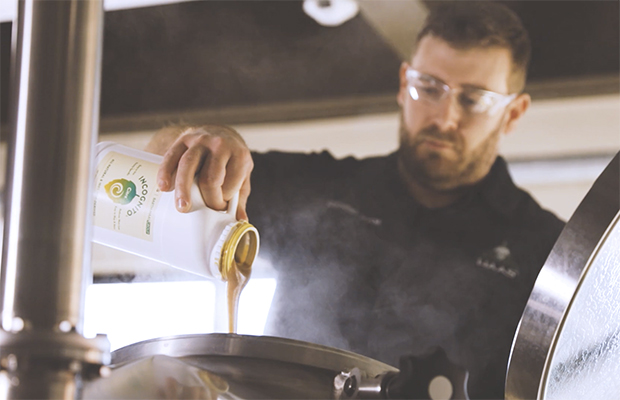
Water in brewing is often overlooked in discussions about beer. Water is in fact the unsung hero behind every pint. It is more than just a solvent to dissolve all the pieces of the beer together, and it is more than just a blank canvas to be painted on. Comprising up to 90% of a beer’s composition, water is the canvas upon which brewers paint their masterpiece.
No two waters are alike, and this holds true for brewing. Different regions possess distinct water profiles, each lending its own character to the beers crafted within its borders. Take Wyoming, for instance, where the soft water serves as a boon for brewers. Soft water, with its low mineral content, is ideal for styles like Pale Ales and Lagers. But before we dive into the science side of water, here are some interesting facts about water and beer.
Water Facts:
- Not often referred to as dihydrogen monoxide (H2O), water is the only substance on Earth that exists naturally in three forms: solid, gas, and liquid.
- It is a polar solvent, with its molecular structure of 2H+ and O-2 making it capable of dissolving both polar and non-polar substances, a trait that earned it the title of the universal solvent.
- By the time you feel thirsty, you have already lost 1% of your total water amount, emphasizing the importance of staying hydrated.
- We can only survive without water for up to a week.
Beer Facts:
- Beer held such significance in ancient Egypt that it was considered a staple food and was even used as a form of currency.
- In ancient Babylon, brewers who produced a bad batch of beer faced a unique punishment. They were drowned in it. Due to its importance, bad beer was more than just bad business, it could sickness and even death in entire towns.
- The oldest known barley fermented drink dates back to 3500 B.C.
- There is a named phobia for the fear of an empty beer glass: Cenosillicaphobia.
Sources of Water
Water is not just a neutral medium for brewing. It is one of the most intriguing substances on the planet. Water comes from three sources, rainwater and snowpack (precipitation), surface water and ground water. Each source with its own characteristics and potential contaminants.
Rainwater and snowpack typically have lower pH (acidic to neutral) and minimal organic matter. Surface waters from lakes and rivers carry more organic matter and dissolved minerals leading typically to more alkalinity (basic). Surface water is also more likely to be inundated with biologicals i.e., plankton, bacteria, fungi. This varies due to location and environmental factors. Groundwater, sourced from aquifers, often has higher mineral content. However, groundwater is more susceptible to industrial and agricultural contaminants.
Regulated water testing for brewing
Water quality directly impacts beer flavor, stability, and appearance. Contaminants like metals, organic compounds, and microbial organisms can alter the taste and even pose health risks. For instance, iron and copper can impart a metallic taste to beer. Microbial contaminants can compromise its stability. Understanding and mitigating these contaminants are crucial for brewers to maintain the integrity of their brews.
Water reports, mandated by the EPA, provide valuable insights into water quality. However, they often prioritize hazardous contaminants over factors that significantly impact beer flavor. That is a good thing. We need to be sure that the water is safe to begin before focusing on the flavor ions. While contaminants are typically assessed, non-regulated items like minerals may be overlooked, due to the cost of testing for the primary and secondary contaminants, despite their influence on brewing.
Water testing for brewing to improve beer quality
Beyond the EPA standards, there are specific elements and minerals that need to be examined when attempting to brew specific beer styles and to maintain consistency in your beer from brew to brew. These are calcium, magnesium, sulfate, chloride, and sodium.
Calcium
Calcium is part of the equation when we talk about total hardness. It is also a great cation (positively charged ion) to be added to your brew because of it’s utility, typically combine with anions (negatively charged ion) such as carbonate, and chloride it has almost no taste in additions of 0-200 ppm, after 200 ppm beer may begin to taste “minerally”. Chemically it reacts with the phosphates in the malt to drive pH down (more acidic) in the mash. Due to its versatility, you do have to be careful monitoring the anions paired with it.
Magnesium
The second half of our hardness equation, magnesium, can lend a bitter astringent flavor to beers especially when over the 50 ppm range anything over 75 ppm, can really lead to that flavor overpowering the rest of the beer flavors. Magnesium chemically reacts very similarly to calcium in the brewing process where it reacts with the phosphates.
Sulfates
Sulfates, usually in the form of gypsum (CaSO4) and epsom (MgSO4) enhance the dryness and accentuates the bitterness of the hop flavor and aroma. At levels over 450 ppm it can begin to be “minerally” when not countered with Chloride.
The recent increase in popularity of IPAs the ratio of sulfates to chlorides is a huge indicator of what type of IPA you are going to brew. A 5:1 sulfate to chloride ratio is the primary distinction between the costal IPAs. The piney, bitter West Coast IPA has a 1:5 sulfate to chloride, whereas the fruity and juicy East Coast/ New England IPA favors the 5:1 sulfate to chloride ratio. That ratio is a huge factor in what flavors are expressed and accentuated from the chosen hops used in the brew.
Sodium
Sodium is the cation where the rule of less is more, is the rule to live by. Anything over the 50 ppm range is going to “salt” your beer. However, in moderate amounts, anywhere from 10-20 ppm it can bring out the sweetness of the malt character.
pH
The pH level of water is not merely a number. It is a conductor orchestrating the symphony of flavors in beer. Water pH impacts aroma perception. Higher pH levels (basic) enhance malt sweetness, while lower pH levels (acidic) accentuate hop bitterness. Thus, water in brewing plays a crucial role in balancing the beer’s taste profile.
There are several minerals in the water that can impact beer flavor profiles. Water testing for brewing is a straightforward way to improve the flavor and consistency of your beer. Ward Laboratories, Inc. can analyze each of these minerals and is the premiere lab for craft brewers and home brewers. Furthermore, we have consultants who can guide you through the process of getting your water into tip top shape for brewing. If you have any questions, we will be happy to walk you through your results.
Clarity and appearance, crucial for visual appreciation, are also affected by water chemistry, impacting beer’s overall sensory experience. Hazy beers are often equated with low quality beers. Ensuring clarity by starting with a solid understanding of the water profile is key to obtaining a crisp clear beer. Irregularities in the starting water profile can lead to diminishing consumer perception of beer quality.
Consistency is king in brewing, and water quality is no exception. Maintaining consistent water quality ensures uniformity in aroma, flavor, and the visual characteristics of the beer from batch to batch.
Each beer style demands a specific water profile to reach its full potential. From Pilsners to IPAs, water quality is key. In the intricate dance of brewing, water takes center stage, guiding the flavors, aromas, and textures of every brew. Understanding its nuances and harnessing its power is the mark of a true brew master. So, the next time you raise a glass, take a moment to toast the unsung hero behind every sip: water in brewing, the foundation of great beer. Cheers!






Be the first to comment